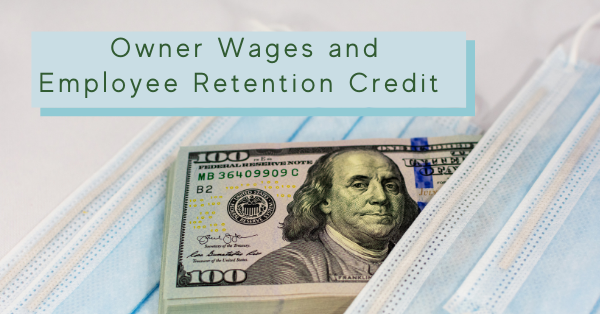Owner Wages and Employee Retention Credit

Note from the Editor: the following article is a good overview of the issue of related parties and the ERTC.
May 26, 2021 by Stephen Nelson CPA
Editor’s Note: The employee retention credit (ERC) potentially provides big tax benefits to employers beat up by the pandemic. But the credit is wickedly complex.
In this guest blog post, nationally known expert Daniel Chodan, a tax partner with the Trout CPA firm in Pennsylvania, explains how the credit works for owner wages. Take it away, Dan!
The Employee Retention Credit (ERC) is a tremendous program for businesses with employees. Refunds can be up to $5,000 per employee in 2020 and up to $28,000 per employee in 2021.
Unfortunately, the ERC is mired in complex rules. Most employers will need to work with a professional to claim ERC as eligibility can be nuanced, reporting a claim is convoluted, and the interplay with other relief programs is intricate (particularly for the Paycheck Protection Program).
The Owner Wages Question
Here is one common question, for example: Can a greater-than-50% owner claim the employer retention credit on their own wages?
We would hope a simple enough question would have a simple answer, but it does not. The underlying IRS code and its practical implications confuses business owners and professionals alike.
I will explain the rules here to show how a greater-than-50% owner’s wages are ineligible for the ERC.
Related Parties Do Not Qualify for ERC
The CARES Act (which creates the employee retention credit) and later IRS guidance states “rules similar to Sec. 51(i)(1) apply” for the credit, which causes certain related individuals’ wages to be ineligible.
Relationships disqualified include the following:
- A child or a descendant of a child;
- A brother, sister, stepbrother, or stepsister;
- The father or mother, or an ancestor of either;
- A stepfather or stepmother;
- A niece or nephew;
- An aunt or uncle; and
- A son-in-law, daughter-in-law, father-in-law, mother-in-law, brother-in-law, or sister-in-law.
Each of the relationships listed is disqualified for ERC if the person is related to a greater-than-50% owner. The confusion begins with this list. Owners and spouses themselves are not listed as disqualified relationships. This has led some to believe owner and spouse wages are allowed for ERC benefits, but further reading will show why they are not.
Attribution Rules Expand the List
The definition of a greater-than-50% owner under Sec. 51(i)(1) is the key issue. The IRS’s ERC FAQ No. 59 indicates it is an individual owning “directly or indirectly” greater-than-50% of the value of stock in a corporation or of the capital and profits interests in the entity.
The term “directly or indirectly” under Sec. 51(i)(1) is defined as being determined with the application of Sec. 267(c). The attribution rules of Sec. 267(c) include entity-to-member attribution, family attribution, partner-to-partner attribution, and limits on reattribution. While all of these rules do apply to the determination of a greater-than-50% owner for ERC, let’s just focus on the family attribution rules for today.
Family attribution of ownership under Sec. 267(c) occurs between the direct owner and the owner’s brothers and sisters (whether by whole or half blood), spouse, ancestors, and lineal descendants. This attribution of ownership occurs regardless of whether the family member owns any portion of the business under Regs. Sec. 1.267(c)-1. As a result, family attribution rules create many indirect owners of a business because they are related to the direct owners of a business. Family attribution also may cause an owner with only a small portion of direct ownership to have a larger portion of both direct and indirect ownership.
What This All Means to Employers
We got a bit technical there, but that is unavoidable to cover this issue. So what does it all mean? It means nothing is easy with ERC.
We might expect to only have a single greater-than-50% owner in a small business, but once the family attribution rules are applied, we will have many greater-than-50% owners.
We then must apply the list of disqualified relationships to each greater-than-50% owner to determine all of the disqualified related party wages. This pattern of attribution of ownership followed by disqualification is ultimately how a greater-than-50% owner’s wages become disqualified.
Let’s look at some examples to see how these rules work practically.
Example 1: S Corporation Owned by Father, Employing Father and Son
As a first example, consider a S corporation owned 100% by a father with the only employees being the father and his son.
The son’s wages are clearly disqualified for ERC as he is a disqualified relationship to a greater-than-50% owner (the father).
The father’s wages are not as clear because owners themselves are not listed as disqualified relationships. However, when we apply the family attribution of ownership rules, we determine there is more than one owner. The father’s 100% ownership attributes to his son, leaving both the father and the son as 100% owners directly and indirectly.
Because the father now has a disqualified relationship to a greater-than-50% owner, the father’s wages are also ineligible for ERC. The same result would occur whether or not the son was employed by the S corporation or had any direct ownership himself.
Example 2: S Corporation Owned by Two Brothers
Another common example is an S corporation owned 50%/50% by two brothers with the only employees being the two brothers.
Since there is no greater-than-50% owner, it may at first seem there are no related-party wages disqualified for ERC. However, when we apply the family attribution of ownership rules, the ownership of each brother attributes to the other and leaves both as 100% owners directly and indirectly.
Because each brother now has a disqualified relationship to a greater-than-50% owner, the wages of both owners are ineligible for ERC.
Example 3: S Corporation Owned by Two Cousins
A final example is an S corporation owned 50%/50% by two cousins with the only employees being the two cousins.
The cousins’ ownership does not attribute to each other by the family attribution rules. So each cousin is only a 50% owner directly and indirectly. However, the cousins’ ownership does attribute to ancestors, including their shared grandmother. The grandmother is considered a 100% owner of the S corporation because she is attributed the ownership of both of her grandchildren (the cousins).
Because each cousin now has a disqualified relationship to a greater-than-50% owner, the wages of both owners are ineligible for ERC.
Where Related Parties Rules Leave Employers
We must achieve full understanding of the direct ownership of a business, the related individuals employed by the business, and the owner family tree(s) for ownership attribution purposes.
The first step is determining who the direct and indirect owners of the business are according to family attribution rules.
The second step is applying the list disqualified relationships as they relate to any direct and indirect greater-than-50% owners.
Further attribution complexities arise when owners are also partners in another enterprise, when multiple layers of ownership exist, or when reattribution is limited, but these topics are beyond the scope of this article.
Often in the end, unfortunately, family attribution of ownership produces unfavorable results by generally disqualifying more wages for ERC. It is always possible that Congress could change the law or the IRS could provide new guidance – but until that happens we are unfortunately stuck with the rules as they are. Advisers and taxpayers should take a close look at these rules before claiming ERC.




